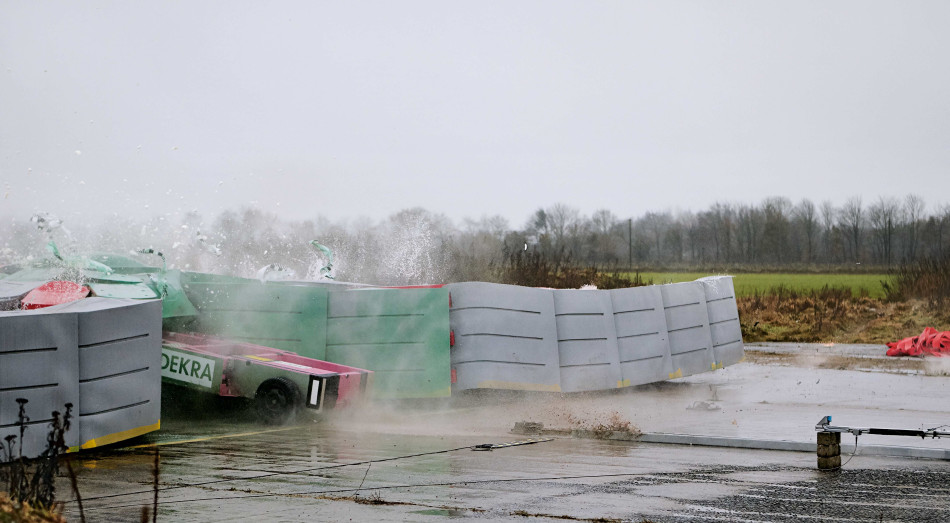From Auto #18: Barrier breakthrough
New high-speed barriers have been implemented at Formula One circuits in 2017, following tests by the Global Institute for Motor Sport Safety

Click here to read the full Auto #18 magazine.
For Carlos Sainz Jr, it was all over in a few seconds. The Spaniardlost control of his Toro Rosso at Turn 13 during the third practice session of the 2015 Russian Grand Prix, glanced off the nearside wall damaging his brakes and slammed nose-first at high speed into the barrier at the far end. He hit that barrier head-on at 153km/h, one of the highest impact speeds measured in Formula One in the last few years, and came to a complete stop in about four metres. The Accident Data Recorder on his car registered a deceleration peak of 42G, but thanks to the absorption properties of the barrier Sainz Jr was unhurt. The only problem was that it was difficult for the F1 medical team to know this as the first row of the barrier came to rest on top of the front of the car and driver during the impact. This is a situation the FIA wants to avoid in future as it could cause problems in cases where a driver has to be removed from a car in short time because of fire or serious injury. So this is why it tasked its research partner, the Global Institute for Motor Sport Safety, with investigating solutions.
UNDERSTANDING THE ACCIDENT
The first thing the Global Institute had to do was understand why the barrier behaved in that way. Did the car ‘submarine’ under the barrier or was there another reason for it to end up on top of the driver? “It looked like the barrier had worked well so we were confused by what had happened and why it was looking like the car went under the barrier,” says Global Institute General Manager Research, Laurent Mekies. After conducting a full analysis of the crash using data recorded from the car, Global Institute Senior Research Engineer Andy Mellor studied additional videos of the impact to understand more. By going through the footage frame-by-frame, he found that the barrier started to go up a couple of tenths of a second after the first contact with the car.
“This was a huge finding because this proved that the car could not have simply submarined the barrier, something else had happened,” says Mekies.
In fact, it revealed that the lifting occurred at very low energy levels, especially during the rebound phase, which was mainly introduced by the bending of the metal Armco behind the barrier in the last part of the impact. This led to an intense five weeks of testing, involving fully recreating the accident at Dekra’s test facility in Eggebek, Germany, to find a solution.
TESTING GROUND
“The first step was trying to reproduce what happened [in Sochi] because if you don’t reproduce it with your testing facilities then you are unlikely to be able to mitigate it,” adds Mekies. “So we set up testing with a full-scale barrier and a trolley at the same weight as an F1 car with a real F1 nose.” Global Institute’s researchers undertook five test sessions – one recreating the accident and the rest testing the theories behind the barrier development. These took place over the course of five weeks, spread throughout 2016, with the stated aim of having the updated solution ready in time for the 2017 season. Simulations had already shown that 2017 cornering speeds would be up to 40km/h faster in high-speed corners, so barrier protection would be even more important. Matteo Piraccini, Senior Research Engineer for the Global Institute, who led the project and managed these tests, says: “As soon as we were able to replicate the conditions of the Sainz crash, this was our reference, our starting point, and it was used to investigate deeply each aspect of barrier behaviour during single phases of the impact.” This meant using the same specification of Armco at the back and the same barrier set-up with the same TecPro elements. Every detail of the configuration had to be accurate. “The nose we used in the construction was a 2015 F1 nose [as per the Sainz crash] because one thing with developing a new barrier is also developing the interaction between the front crash device and the barrier itself. So we didn’t want to run the risk of introducing a new variable. We performed a 90-degree full-scale test targeting the same impact speed of the crash at Sochi.” This was achieved using a pulley system, which fired the trolley at the barrier. The trolley was fully equipped with sensors, which were synchronized with high-speed cameras placed around the test area to ensure the correlation between data analysis and video. Having successfully recreated the accident with a comparable level of deceleration peak, Piraccini soon discovered that to mitigate the lift-up tendency of the barrier during the rebound phase the main area to develop was not only the barrier configuration, but also the TecPro elements themselves. The solution was to give each element a lower centre of gravity, increased weight and a stronger internal structure, all of which would help to prevent the element from leaving the ground. To achieve this, Piraccini worked with TecPro to develop the internal structure of the element. The new solution is heavier than before meaning that the element’s centre of gravity is now lower. At the same time, the new layout increases the strength of the full internal structure, while improving the element’s anti-penetration capability. “Thinking about the Formula One nose like a knife, with the new element it is less easy for it to penetrate the internal structure because the new solution gives it more strength,” explains Piraccini. “We are not talking about a brand-new barrier, we are talking about a natural step forward of the barrier that was designed and tested in the past, and which was already approved. This is the solution to mitigate a particular problem, increasing also the absorption properties of the barrier during an impact.”
READY FOR RACING
For the 2017 F1 season it has been important that those circuits with high-speed corners implement these new barriers. “We are not asking them to replace everything, just update the barriers where we think there is a critical area, considering a few elements in that critical area. We are talking about a minimum but important change in a few corners.” FIA F1 Race Director Charlie Whiting is particularly pleased that this project has been completed in time for the start of the new season. “I think it was important to get this project finished in preparation for this season as it will help circuits adapt more easily,” he says. “Although when we embarked on the development we didn’t know how fast the cars would be of course, we have a much better idea now.” With faster cars and wider tyres, the 2017 F1 season is set to be an exciting one. And with the implementation of new barriers in the highest speed corners it is set to be safer too.

 Facebook
Facebook Twitter
Twitter






